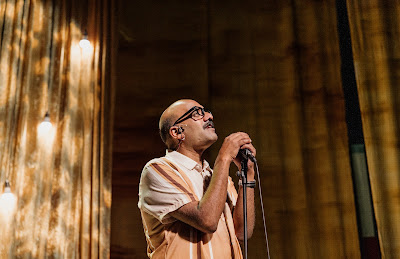When the girl of his dreams is kidnapped, a man incapable of feeling physical pain turns his rare condition into an unexpected advantage in the fight to rescue her.
Blending over-the-top action with a twisted sense of humour, Novocaine is the kind of film that thrives on its own absurdity. It takes a wildly imaginative premise—what if a man couldn’t feel pain?—and runs with it, delivering a blood-drenched spectacle that manages to be both hilarious and horrifying. Directors Dan Berk and Robert Olsen craft a film that revels in its gruesome creativity, but while it starts strong, Novocaine gradually loses its sharpness, stretching its concept to the breaking point by the time the credits roll.
At the heart of Novocaine is Nate Caine, played with endearing awkwardness by Jack Quaid. Unlike the typical action hero, Nate is neither skilled nor particularly brave—he’s a nervous wreck who has spent his entire life shielding himself from harm. His condition, Congenital Insensitivity to Pain (CIP), means he can’t feel injuries, making him a walking disaster just waiting to happen. To compensate, Nate has bubble-wrapped his existence, covering sharp corners with padding, avoiding physical exertion, and sticking to a safe, predictable routine.
That routine shatters when his workplace—a small-town bank—is violently robbed. Amid the chaos, his co-worker and crush, Sherry (Amber Midthunder), is taken hostage, forcing Nate into action. What follows is a relentless series of encounters in which Nate fumbles his way through increasingly brutal fights, unintentionally turning into an unbreakable, pain-free force of nature. With an injury list that would put most action heroes in the hospital, he barrels through gunfights, fistfights, and absurd booby-trapped environments, all while remaining blissfully ignorant (or unaware) of the extent of his wounds.
Berk and Olsen lean into the inherent comedy of Nate’s condition. The film plays with slapstick violence in a way that echoes Home Alone—except instead of cartoonish pratfalls, we get impalements, bear mace, and creatively gruesome injuries. The action sequences are inventive, making full use of Nate’s unique physiology. Whether he’s shoving a handful of broken glass into someone’s face, using a tattoo needle in a lethal way, or accidentally deep-frying a gun, the film finds increasingly bizarre ways to keep the carnage flowing.
Jack Quaid’s performance is key to making all of this work. He brings a nervous, everyman energy to the role that makes Nate feel grounded, even as the film spirals into madness. Quaid has made a name for himself playing endearing, slightly dorky characters, and Novocaine plays to his strengths. His awkward charm gives the film a comedic edge, helping balance out the buckets of blood.
Despite its strengths, Novocaine isn’t without flaws. The film’s emotional core never quite lands. While Nate’s journey from terrified recluse to accidental vigilante is engaging, his relationship with Sherry feels underdeveloped. Midthunder does her best with the material, but her character never escapes the role of a damsel-in-distress plot device. The romance feels rushed, lacking the depth needed to make their connection feel real.
Ray Nicholson, playing the film’s main antagonist, delivers a performance that is more eccentric than menacing. He chews the scenery with glee, but his villain never truly feels like a threat. The stakes remain high on paper, but without a truly terrifying antagonist, Nate’s journey lacks the sense of real danger that could have elevated the story.
Another issue lies in the film’s pacing. While Novocaine starts with a bang, keeping the action and laughs flowing in its first half, it eventually begins to drag. The central gimmick—Nate’s inability to feel pain—initially provides a fresh spin on action tropes, but by the final act, the film struggles to find new ways to keep it engaging. The action sequences, while well-choreographed, start to feel repetitive. Unlike traditional action films where the audience winces at every punch and kick, Novocaine lacks that sense of physicality—because Nate himself never reacts to pain, the fights often feel weightless.
This lack of impact becomes more noticeable as the film tries to escalate the chaos. Instead of tightening the narrative, Novocaine expands outward, adding unnecessary locations, fights, and quips that dilute its momentum. By the time it reaches its climax, the film has lost some of its initial bite, feeling more like a collection of violent set pieces than a fully realised story.
It’s a common pitfall in action-comedies that lean heavily on a single concept. Films like Crank or The Transporter work because they embrace their absurdity but still find ways to make their action sequences feel visceral. Novocaine, on the other hand, leans so far into its pain-free gimmick that it sometimes forgets to make its fights feel impactful.
That said, Novocaine remains an entertaining ride. Its blend of blood-soaked action and dark comedy makes it a fun watch, even if it stumbles in its later half. Jack Quaid carries the film with his earnest performance, and the directors’ background in horror allows them to inject moments of genuine suspense amid the chaos. While it might not be a genre classic, it carves out its own niche as a gory, absurd, and oddly tender action-comedy.
For those looking for a unique twist on the action genre, Novocaine delivers plenty of blood, laughs, and sheer ridiculousness. It may not be a film that lingers in your mind long after the credits roll, but for 90 minutes of unhinged fun, it does the job.
Novocaine is releasing in NZ cinemas on April 3, 2025











.jpg)































